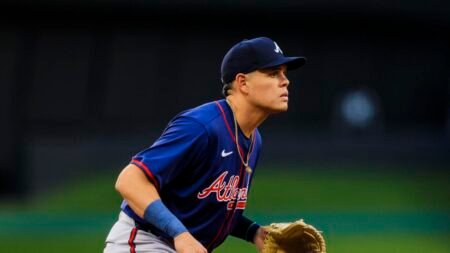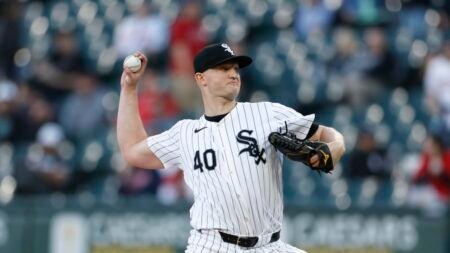Even though Spring Training has wrapped up, that’s no reason for us to stop looking into pitchers who are throwing new pitches. In fact, this is when the fun begins. Many pitchers will test new pitches in the spring but then abandon them when the regular season starts. It can often be more informative to see which pitchers have drastically changed their pitch mix or pitch shape after a few starts in the regular season.
With that in mind, we will continue with the premise of the series I had called Pitchers with New Pitches (and Should We Care) by breaking down notable changes in a pitcher’s pitch mix (hence “Mixing” it up). We’ll look at pitchers who are throwing a new pitch, have eliminated a pitch, or are showcasing a different shape/velocity on a pitch.
I’ll continue my analysis with the simple premise that not every new pitch should be greeted with praise. A new pitch, like a shiny new toy, might be exciting on its own, but it also needs to complement what a pitcher already has and fill a meaningful void in his current pitch mix. We want to check and see if he has any splits issues. We want to see what his best pitch(es) is and see if this new pitch would complement that. Then we want to see what this new pitch type is generally used for (control, called strikes, etc.) and see if that is something this pitcher needs help with. We can also now see the pitch in action to look at the shape and command and see if it’s actually any good. Once we’ve done all that, we can decide if the pitch is a good addition or not.
If you missed any of the previous editions of this series, you can click this link here to be taken to the tracker, which I’ll update as the season goes on. It will also include links to the original articles so you can read them in full if you’d like.
Listen to the Rotoworld Baseball Show for the latest player news, waiver claims, roster advice, and more from our experts all season long. Click here or download it wherever you get your podcasts.
It hasn’t been a great start to the year for Max Fried after he couldn’t get out of the first inning in his first start against the Phillies and then labored through 4 1/3 against the Diamondbacks. However, he seemed to get things in order in his last start against the Marlins, so perhaps we can still see Fried as an ace this season.
One of the things he came into the season looking to improve upon was some of his swing-and-miss issues against righties. In 2023, he had a 15.5% swinging strike rate (SwStr%) against lefties and a 12% mark against righties. Part of that issue stems from his two best swing-and-miss pitches being his change-up and his curve, with the curve being much less effective against righties. Considering Fried’s harder, gyro slider was also more effective against lefties in 2023, Fried really only had one pitch to get swings and misses against righties, and a change-up is not a great two-strike offering for strikeouts.
That could be part of the reason that Fried tweaked his slider this season.
Last year, he threw his slider at 85.5 mph and it had almost five inches of horizontal movement and two inches of drop. That pitch had a 10.7% SwStr% overall and a 9.6% mark against righties while giving up a 40% Ideal Contact Rate (ICR) and a 22.2% HR/FB rate. Those aren’t horrendous numbers, but they’re also not great, even if the pitch graded out well overall.
This season, he seems to have transitioned more to a sweeper, throwing that old version of his slider just 4% of the time. Instead, he’s using a sweeper 15% of the time. The pitch is 79.1 mph with seven inches of drop and 15 inches of sweep. Since Brooks Baseball doesn’t differentiate between types of sliders, you can see how the vertical movement on Fried’s primary slider has changed in the chart below.
Overall, the sweeper has graded out as a good pitch for Fried with a 5.61 PLV score from Pitcher List. It’s registered a 15.2% SwStr% so far this season, but he also feels more comfortable throwing it to right-handed hitters since he has way more drop than a normal sweeper, so it doesn’t float into a righty’s hitting zone as often. He’s used the pitch 12.3% of the time to righties alone this season, posting a 20% SwStr% and not allowing a single barrel. That’s a pretty good start.
What’s more, this version of the slider seems like one he can command much better. It has a 61% zone rate and 70% strike rate this season as opposed to a 43% zone rate and 60% strike rate on his older slider. Any time you can add more movement but also get better command, that’s something we like to see.
VERDICT: MARGINALLY IMPACTFUL. Fried throws six pitches and his sweeper is used just 15% of the time, so this isn’t a pitch that’s going to drastically change his profile. However, it appears to be a better version of his slider and will give him more swing-and-miss upside against righties, so that’s something that could improve his fantasy upside just a little bit.
The early season injury to Tylor Megill opened up a spot in the Mets rotation. They chose to use that spot on Julio Teheran for one start and that, as expected, didn’t work out so well. Buttó got a shot against the Royals on Sunday and shoved. There is a chance that he could lose his rotation spot with Megill nearing a return, but I think Buttó should get another crack with the Mets trying Megill in the bullpen.
Last year, Buttó was solid for the Mets, pitching to a 3.64 ERA with a 1.33 WHIP but a poor 8.4% K-BB%. He needed not just more swing-and-miss in his game, but he also needed to add something he could command better in the zone to decrease those walks. The two changes to his slider could do both of those things.
Last year, Buttó technically had five pitches, but he didn’t throw his sinker or curve much, so he was more of a three-pitch guy with a fastball that didn’t miss bats (9.4% SwStr) and a slider that had a good 16.8% SwStr% to righties but he couldn’t command with a 40% zone rate and 57% strike rate. As a result, Buttó used his change-up 55% of the time in two-strike counts to right-handed hitters. 55% TWO STRIKE CHANGEUPS TO RIGHTIES!!! That’s not the best use for that pitch, and it’s not a shock that the pitch had just a 12% putaway rate. So his most-used two-strike pitch was not effective in missing bats in those counts. That’s not what you want.
As part of his pitch mix change, he ditched his curve, which he threw just 5% of the time last year, and turned it into a sweeper. The sweeper grades out at 5.52 PLV on Pitcher List and has 14.4 inches of horizontal break and just under nine inches of drop at 81.8 mph. That has some curveball shape but has 10 inches more sweep and is three mph harder than the curve he threw last year.
On the surface, this could be the swing-and-miss pitch that Buttó needs. However, in practice, the pitch has a 9.1% SwStr% to right-handed hitters this season and Buttó has a 0% zone rate. Wait, what!? Yeah, he hasn’t thrown it in the zone once. He’s thrown it 11 times in two starts, seven of them have been for a ball, two of them went for hits on pitches outside of the zone and the other two were swinging strikes on pitches under the zone. That’s a really small sample size, but that’s not working so far.
What is working is that Buttó turned last year’s version of a slider into more of a bullet slider. He’s throwing it about 1.6 mph slower than last year with slightly more drop but less horizontal movement than last year. The pitch jumped from a 4.79 PLV grade to 5.16. Even though both are still below average, this version of the slider has a 16.7% SwStr% against righties this year. It also has a solid 25% PutAway rate in two-strike counts, which is what we like to see even though he’s only using it 22% of the time in two-strike counts against righties, which is likely because he’s only thrown it in the zone 21% of the time this year. Yeah, that’s not great.
VERDICT: POTENTIALLY IMPACTFUL. On the surface, these changes could be good for Buttó . However, the sweeper is not missing bats so far and he hasn’t been able to throw either version of the slider for strikes. His zone rate is both way worse than last year and well below the league average. I know the results have been good so far, but this feels a bit risky without actually having command of the gyro slider or sweeper.
Cristian Javier – Houston Astros (Changeup)
In my final starting pitcher rankings for the season, I ranked Cristian Javier 54th and said: “Last year, he totally lost the feel for his slider, so his whiff rates fell and it allowed hitters to pounce on his four-seam. But that’s the risk with a pitcher who throws his four-seam/slider combo 88% of the time. The four-seam has elite IVB and misses a decent number of bats, but it’s not good enough to carry the entire arsenal. Javier needs to find that slider again, but even if he does, he’s still essentially a two-pitch pitcher, and that worries me.”
We can get the bad stuff out of the way first and say that Javier has certainly not found his slider. The pitch has gotten worse in some ways. Last year, he posted a 42% zone rate and 10.4% SwStr%, but this year he has a 34% zone rate and 8% SwStr%, so he’s not commanding it in the zone as often and also not missing as many bats. That could be a big part of the reason that Javier has seen his SwStr% overall plummet to 11.1% as he has just 18 strikeouts in his first 23.1 innings.
However, all is not lost.
Javier has added that third pitch I was hoping for in the form of a revamped change-up. He’s throwing the pitch 2.3 mph slower this year and has also reduced both the vertical and horizontal movement. That new movement profile allows the pitch to play off his four-seam better and he has far better command of the pitch, increasing his zone rate by over 10% and his strike rate by 14%. That better feel for the pitch has also led him to use it more, throwing it 27% of the time in 2024, as opposed to just 4% last year.
Part of the success of the change-up has been his elite command of it. Javier is peppering the lower part of the zone, throwing the pitch low almost 74% of the time and keeping it arm-side 51% of the time.
He does move the pitch more to the middle against righties, but he still has an 80% low location against right-handed hitters, which is why even righties aren’t able to make good contact on the pitch with just a 28% ICR.
One of the tradeoffs of being more changeup-focused, unless he can figure out his slider, is that Javier may see a dip in strikeout rate. The pitch has a 14.3% SwStr% overall but just an 11% PutAway rate and isn’t a good two-strike pitch. It will help him get ahead and limit hard contact, but he’s going to need something else to get punchouts.
VERDICT: MEANINGFULLY IMPACTFUL. We can’t blame the changeup for his poor strikeout rate. That’s an issue with the slider. The changeup has given Javier a much safer ceiling and allowed him to limit hard contact. Even without the slider, it makes me a little less nervous about using Javier but he becomes a good ratio and low strikeout arm. If that slider returns, he could be a top-30 pitcher.
This is more about usage than a new pitch, but I wanted to include it here. For a few years now, I’ve been saying that Ashcraft needed another pitch besides his cutter and sweeper. They both grade out really well, so he pops on Stuff+ lists, but both pitches move away from righties, so he has had reverse splits in the past.
Righties never needed to protect the inside of the plate against Ashcraft, and when hitters don’t need to worry about half of the plate, they are always going to be better. They were able to look for something away, and Ashcraft wasn’t getting as many swings and misses as he should have with his stuff. I had wanted him to add a change-up or maybe a curve so that he could throw something softer that he could use inside; however, it seems that he’s relying more on a sinker this season.
Last year he used the pitch 12% of the time to righties, but now he’s using it 36% of the time. As a result, he’s throwing his cutter to righties just 20% of the time after throwing it 47% last year. While the sinker doesn’t grade out well, he is pounding the zone with it and limiting hard contact. The pitch has a 76.6% strike rate to righties with a 23% ICR allowed. That’s the good part.
The bad part is that Ashcraft may be throwing it for strike but he’s not commanding it well. He has a 19% mistake rate on the pitch to righties, according to Pitcher List, which means he’s missed his spot and thrown the sinker near the middle of the plate one almost one out of every five pitches. That’s way too high. He’s also throwing it inside to righties just 42% of the time but keeping it glove-side 32% of the time. I don’t need him to be throwing a sinker away from righties because all of his other pitches are already attacking that same area. At the end of the day, is this better? Sure, but I would still prefer a curve or change-up.
VERDICT: NOT IMPACTFUL. Ashcraft was solid in his season debut against the Phillies and then looked good against the White Sox, but I don’t think there is any real growth here. Yes, the sinker should limit some hard contact against righties, and we like that, but he’s struggling to command the pitch and is also now struggling to command the cutter, so that pitch is regressing against lefties. I guess he could be a more reliable streamer in plus matchups now, but I still think this is not something worth chasing.
Read the full article here














